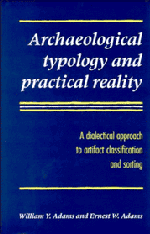 Archaeological Typology and Practical Reality
Archaeological Typology and Practical Reality Book contents
- Frontmatter
- Contents
- List of figures
- List of tables
- The archaeologist's preface
- The philosopher's preface
- PART I Introductory
- PART II The nature of types and typologies
- 3 Dimensions and elements of “typehood”
- 4 Perceptual and conceptual foundations
- 5 The dialectics of type formulation
- 6 The nature of types
- 7 The structure of typologies
- 8 A synthetic definition of typology and type
- PART III Typology in action: the Medieval Nubian Pottery Typology
- PART IV Pragmatics of archaeological typology
- PART V Classification, explanation, and theory
- Appendices
- References
- Index
4 - Perceptual and conceptual foundations
Published online by Cambridge University Press: 23 November 2009
- Frontmatter
- Contents
- List of figures
- List of tables
- The archaeologist's preface
- The philosopher's preface
- PART I Introductory
- PART II The nature of types and typologies
- 3 Dimensions and elements of “typehood”
- 4 Perceptual and conceptual foundations
- 5 The dialectics of type formulation
- 6 The nature of types
- 7 The structure of typologies
- 8 A synthetic definition of typology and type
- PART III Typology in action: the Medieval Nubian Pottery Typology
- PART IV Pragmatics of archaeological typology
- PART V Classification, explanation, and theory
- Appendices
- References
- Index
Summary
In Chapter 3 we discussed the physical, mental, and representational elements that go into the making of a type. Of these it is the mental elements that are the most problematical, and also, surprisingly, the least considered in the literature on typologies. As Lakoff (1984: 22) observes, “the classic theory of categories is not a cognitive theory. It is a theory about things as they are in the world, not about how the mind makes sense of the world.” He goes on to remark: “I do not know why the … theory of categories should be an Aristotelian one. But it is an issue that cognitive scientists need to address” (ibid.: 26).
The mental dimensions of typehood will be our concern in the next two chapters. In the present chapter we will discuss the relationship between types and other, related mental constructs: concepts, categories, and classes. Our purpose here is not to develop a theory of knowledge or of classification, but simply to establish working definitions for a great many terms that we will employ later in the book. Much of what we say here is not critical to the arguments that we will present later in regard to the use of types; our purpose is simply to make our meanings clear. We must stress once again that our definitions do not necessarily coincide with those of other authors (see Chapter 1).
Types and scientific thought
Science is defined more by its purposes (ends) than by its methods (means).
- Type
- Chapter
- Information
- Archaeological Typology and Practical RealityA Dialectical Approach to Artifact Classification and Sorting, pp. 39 - 49Publisher: Cambridge University PressPrint publication year: 1991


